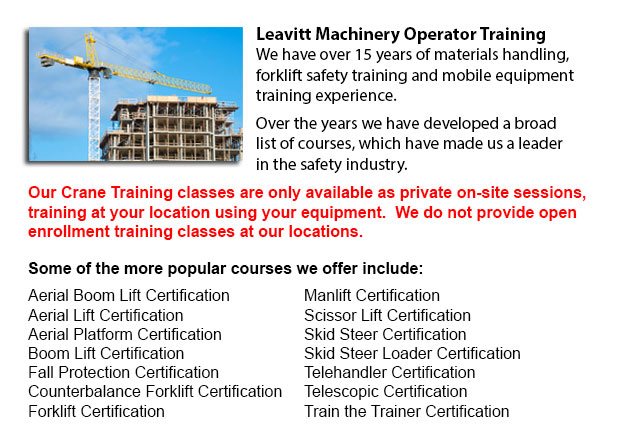
Guelph Overhead Crane Operator Training - The program teaching overhead crane operator training has been meant specially to instruct trainees on the basics of pre-shift inspections and overhead crane/sling operation. The courses are instructed by expert trainers and consultants. Well-trained workers are more productive and efficient, that saves on expenses connected with property damage, merchandise damage, and accidents due to the use of incorrect operating procedures. Our overhead crane certification is customized for staff who have literacy barriers, reducing certification time by 50 percent.
Overhead cranes are best for specific repetitive lifting activities. This type of crane has wide ranging capacities. They could be utilized for specialized hoisting jobs like for example installing or removing major plant machines.
In order to safely operate an overhead crane, personnel must employ safe rigging practices. This requires both knowledge and practice. The load should be rigged correctly to guarantee its stability when lifted. Prior to beginning a lifting task, it should be determined that the crane is suitable for the task, with appropriate lift, capacity and travel. The crane should be subjected to a thorough physical and visual inspection before use. The capacity of all equipment, including the slings, hardware and rope, must never exceed load weight capacities.
Prior to utilizing the rigger should know which sling is best for every lift and must inspect the rigging hardware and gear. The communications that are used with the crane operator should be clear and concise. A signaler has to be chosen for the role and signals have to be agreed upon. The operator of the crane should follow instructions from the designated person only. If a wired or remote controller is being used, the operator should be trained in all its functions.
In order to ensure the safety of staff, a warning needs to be issued and the path of the load must be cleared of all obstructions before the lift begins. People must not be allowed to walk under the lift loads. The crane hoist should be centered over the load before hoisting in order to prevent swinging. The safety catch needs to be closed instantly after sliding the sling entirely onto the lifting hook. Unused sling legs should be secured so they do not drag. Never leave loose materials on a load being hoisted. Watch that hands and fingers are clear when slack is taken out of a sling. Before the lift is made, step clear of the danger zone.
-
Guelph Warehouse Forklift Training Classes
Guelph Warehouse Forklift Training Classes - Warehouse training classes exist for the reason of raising awareness regarding common warehouse hazards. Students learn the important safety procedures that are necessary to warehouse safety. An emphasis i... More -
Guelph Forklift Operator Certification
Guelph Forklift Operator Certification - Certification for forklifts are needed to guarantee the safe use of forklifts for those employers in construction, industrial and warehouse settings. The training has to involve a method of education plus some... More -
Guelph Crane Training School
Guelph Crane Training School - The crane training school offers industry-relevant programs. Courses provide trainees with learning results that match current industry demands. Our small class sizes combine hands-on experience and theory. Our qualifie... More -
Guelph Heavy Equipment Training Programs
Guelph Heavy Equipment Training Programs - At whatever given construction site, there are usually various kinds of machines that are ready to be used. These heavy and light equipment need both operators to run them and mechanics to fix them. Apprenti... More -
Guelph Skid Steer Ticket
Guelph Skid Steer Ticket - On a skid-steer loader, the lift arms are at the side of the driver together with pivot points at the back of the driver's shoulders. This makes them different compared to a traditional front loader. Because of the operator... More -
Guelph Zoom Boom Ticket
Guelph Zoom Boom Ticket - Zoom Boom Training focuses on correctly training prospective operators on variable reach forklifts. The training goals include gaining the understanding of the equipments physics and to define the tasks of the operator. This... More -
Guelph Heavy Equipment Training
Guelph Heavy Equipment Training - Commonly, the different types of heavy equipment training are divided into 2 categories of machinery: those that have rubber tires and tracked vehicles. Tracked vehicles consist of items like for instance bulldozers,... More -
Guelph Aerial Lift Safety Training
Guelph Aerial Lift Safety Training - Each year, there are roughly 26 construction deaths due to the use of aerial lifts. Nearly all of the craftsmen killed are laborers, electrical workers, carpenters, painters or ironworkers. Nearly all deaths are c... More

Forklift Certification Guelph
TOLL FREE: 1-888-254-6157
Guelph, Ontario
forkliftcertificationguelph.com
Email Us
About Us


